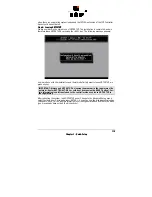
&KDSWHU&*'78VHUV0DQXDO
After pressing <F2> we get detailed information on the structure of the disk array. The last
entry refers to the
Priv. Hot Fix
drive.
We have already seen this form before, with the only difference that DISK_C2 has been as-
signed to be the Hot Fix drive. We now leave GDTSETUP as described in example no. 3, in
order to allow GDTSETUP to send all relevant information to the controller and let
RAIDYNE create and store the redundant information.
The question that arises now is:
When and how does the Hot Fix mechanism work ?
Normally, RAIDYNE puts Hot Fix drives in a stand-by mode, that is, their motors are
stopped. However, it may happen that certain operations such as loading drivers, starting
GDTSETUP and so on, cause the Hot Fix drives to start their motors. This takes a little bit
longer, but it is necessary in order to enable RAIDYNE to check the consistency of the
setup. RAIDYNE substitutes a failed hard disk with a Hot Fix drive only if the array was in a
ready
state before the failure. Or, in other words, a Hot Fix drive can only be activated if the
corresponding disk array was in a state of data redundancy at the moment of failure.
Important:
The following partial step can only be performed if the disk array is in the
ready
state.
6WHS6LPXDUG'LVN)DLOXUH:KHQD+RW)L['ULYHLV3UHVHQW
This partial step is optional. However, we recommend that you carry it out in order for you
to get an idea of how RAIDYNE reacts in such a situation and which steps need to be taken.
To have a very realistic simulation, create a DOS-partition and generate load on your disk
array by using a batch file with copy commands. During these copy operations we cause
DISK_B2 to fail by plugging out its power supply. (If you choose to let another drive fail,
keep in mind the section of step 1 referring to the SCSI-bus termination).
We now observe how RAIDYNE reacts:























